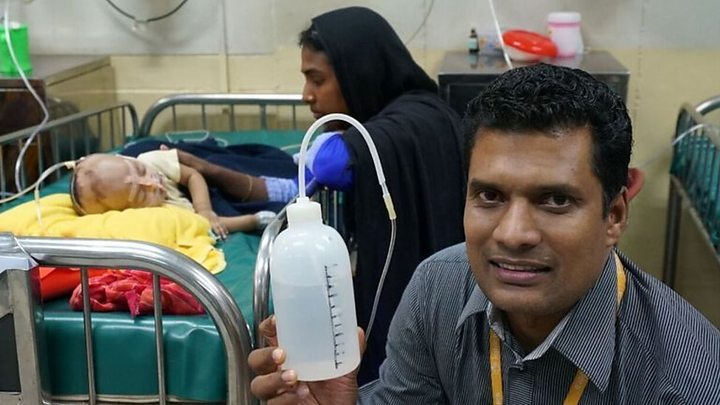As far as the Cholera Hospital aspect of the hospital--there is a real rhythm to how patients are treated with diarrheal illness, less so Cholera now, but diarrheal disease in general is still a very big problem here. The hospital has beds with strategically placed holes in the bed, the wards are cleaned and sprayed down at regular increments throughout the day, bags of saline hang on each bed, ready to be spiked as soon as a patient is placed in the bed.
Regarding the second reason we had visited the ICDDR,B--to meet up with Dr. Chisti, a wonderful physician and brilliant scientist who is so very kind hearted as he took time out of a very busy schedule to sit down and talk about how we can collaborate in the future as one of his upcoming projects will involve the use of the ultrasound! I was also curious to see the "bubble CPAP" that he has recently received international recognition for!

The bubble cpap is an already existing low-tech intervention which has been used for neonates mostly. It has split tubing, one that delivers oxygen to the child through nasal prongs, the other is a tube that goes from the nasal prongs to a bottle with water, as the patient exhales, bubbles are created in the bottle and a certain amount of pressure is applied to keep open the air sacs in the lungs thereby improving oxygenation. He extrapolated the use of this from neonates to the pediatric population and has preliminarily shown the number of deaths from severe pneumonia decrease. Granted, he is still in the phase of research and development of this low-tech device which can be used in a setting such as this, its implications are vast.
We were incredibly impressed by the work they continue to do at the ICDDR and I am hopeful that I can collaborate with Dr. Chisti in the future along with those who are experts in pediatric ultrasound (not my forte so I'll be calling on those of you out there who are!)The following day we delivered an abbreviated version of the ultrasound course to a group of 20 physicians at BIRDEM hospital--a hospital which specializes in patients with complications from diabetes. As are many of the hospitals here, it is filled to the brim with sick patients. With a country the size of Wisconsin with 164 million people (8 million of whom live in Dhaka) it is no wonder that there is a need for SEVERAL hospitals and they are ALL full! For each course that we teach we do our best to remember that the local machine used may be different. Teaching on the machine available is also a very important aspect (something that requires figuring out the machine on the fly...something I feel has gotten easier the more I do this)--but also showing the importance of having quality images is equally as crucial. While the concepts may be exhausting and challenging to teach all of those issues are moot when the trainees are able to acquire beautiful images. Seen below one of our trainees, after several hours of instruction throughout the day and near the end of our hands on session, is acquiring a beautiful image of a typically challenging view of the heart.
Signing off for today--next up:
a visit to an orphanage in Dhaka which has several education and health care initiatives
our last two sessions at our third and final site in Dhaka



No comments:
Post a Comment